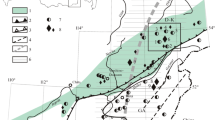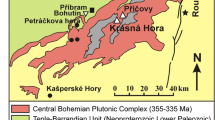Abstract
Data on fluid inclusions and stable isotope compositions (O, H, C, and S) in minerals have been summarized for large-and middle-scale mesothermal gold deposits (Nezhdaninsk, Berezovsk, Kochkar’, Svetlinsk, Darasun, and Maisk), cassiterite-silicate-sulfide deposits of Sikhote Alin (Solnechnoe, Arsen’evsk, and Vysokogorsk), vein silver-base metal deposits in the Southern Verkhoyansk region (Prognoz and Kupol’noe), and epithermal copper-bismuth-silver-base metal deposits of the Karamazar district in Tajikistan (Kanimansur, Tary Ekan, and Zambarak). It is shown that ores precipitated from fluids with salinity varying from brines (up to 60 wt % NaCl equiv) to dilute fluids (1–3 wt % NaCl equiv). As a rule, fluids of different compositions entered the hydrothermal-magmatic system. A fluid mixture of H2O-CO2-NaCl±CH4±N2 predominated in the orogenic (mesothermal) gold-bearing hydrothermal systems, with deposition of the final-stage gold-bearing sulfosalts from aqueous-salt fluid. Brines played a significant role in the formation of cassiterite-silicate-sulfide and vein silver-base metal deposits. The brines often coexisted with a low-density vapor-rich fluid at the ore deposition site. The obtained data suggest a predominant magmatic component in the hydrothermal-magmatic systems, with a significant contribution of meteoric waters.
Similar content being viewed by others
References
E. Yu. Anikina, N. S. Bortnikov, and G. N. Gamyanin, “Rhythmical and Banded Veins at Silver-Lead-Zinc Deposits of the Kolyma-Verkhoyansk Fold Belt. Russia: Implications for Fluid Boiling,” in Mineral Exploration and Sustainable Development (Milpress, Rotterdam, 2003).
A. Audetat, D. Gunther, and C.A. Heinrich, “Magmatic-Hydrothermal Evolution in a Fractionating Granite: A Microchemical Study of the Sn-W-F-Mineralized Mole Granite (Australia)”, Geochim. Cosmochim. Acta 64, 3373 (2000).
R. J. Bodnar, T. J. Reynolds, and C. A. Kuehn, “Fluid Inclusion Systematics in Epithermal Systems,” in Geology and Geochemistry of Epithermal Systems (Econ. Geol, El Pasco), pp. 73–97 (1984).
A. S. Borisenko, “Cryometric Study of Salt Composition in Gas-Liquid Inclusions in Minerals,” Geol. Geofiz., No. 8, 16–27 (1977).
N. S. Bortnikov, I. A. Bryzgalov, N. N. Krivitskaya, et al., “The Maiskoe Multimegastage Disseminated Gold-Sulfide Deposit-(Chukotka, Russia): Mineralogy, Fluid Inclusions, Stable Isotopes (O and S), History, and Conditions of Formation,” Geol. Rudn. Mestorozhd. 46(6), 475–509 (2004) [Geol. Ore Dep. 46 (6), 409 (2004)].
N. S. Bortnikov, G. N. Gamyanin, V. A. Alpatov, et al., “Mineralogy, Geochemistry and Origin of the Nezhdaninsk Gold Deposit (Sakha-Yakutia, Russia),” Geol. Rudn. Mestorozhd. 40(2), 137–156 (1998) [Geol. Ore Dep. 40 (2), 121 (1998)].
N. S. Bortnikov, A. I. Khanchuk, T. L. Krylova, et al., “Geochemistry of the Mineral-Forming Fluids in Some Tin Ore Hydrothermal Systems of Sikhote Alin, Russian Far East,” Geol. Rudn. Mestorozhd. 47(5), (2005) [in press].
N. S. Bortnikov, V. Yu. Prokof’ev, and N. V. Razdolina, “Environment of Ore Deposition in the Charmitan Gold Vein Deposit, Nurata Mountains, Usbekistan, USSR,” in Proceedings of 29th International Geological Congress, Kyoto, Japan, 1992 (Kyoto, 1992), Vol. 3, p. 748.
N. S. Bortnikov, V. Yu. Prokof’ev, and N. V. Razdolina, “Origin of the Charmitan Gold-Quartz Deposit (Uzbekistan),” Geol. Rudn. Mestorozhd. 38(3), 238–257 (1996) [Geol. Ore Dep. 38 (3), 208 (1996)].
N. S. Bortnikov, V. N. Sazonov, I. V. Vikent’ev, et al., “Role of the Magmatogenic Fluid in the Formation of the Mesothermal Berezov Gold-Quartz Deposit,” Dokl. Ross. Akad. Nauk 363(1), 82–85 (1999) [Dokl. Earth Sci. 363 (8), 1078 (1998)].
N. S. Bortnikov, V. N. Sazonov, I. V. Vikent’ev, et al., “The Berezovsk Giant Gold Quartz Deposit, Urals, Russia: Fluid Inclusion and Stable Isotope Studies,” in Mineral Deposits: Research and Exploration—Where Do They Meet? (Balkema, Rotterdam, 1997), pp. 157–160.
N. S. Bortnikov, M. I. Stolyarov, V. V. Murzin, et al., “The Svetlinsk Gold-Telluride Deposit, Urals, Russia: Mineral Paragenesis, Fluid Inclusion, and Stable Isotope Studies,” Mineral Deposits: Processes to Processing (London, 1999), pp. 21–24.
T. S. Bowers, “The Deposition of Gold and Other Metals. Pressure-Induced Fluid Immiscibility and Associated Stable Isotope Signatures,” Geochim. Cosmochim. Acta 55(9), 2417–2434 (1991).
P. A. Candela and P. M. Piccoli, “Model Ore-Metal Partitioning from Melts into Vapor and Vapor/Brine Mixtures,” in Magmas, Fluids, and Ore Deposits, Mineral. Assoc. Can. Short Course Ser. 23, 101–127 (1995).
C. W. Field and R. N. Fifarek, “Light Stable-Isotope Systematics in the Epithermal Environment,” Geology and Geochemistry of Epithermal Systems (Econ. Geol., El Pasco), pp. 99–128 (1985).
B. L. Flerov, “Tin-Base Metal Ore Mineralization of Southeastern Yakutia,” in Geology, Mineralogy of the Ore Clusters of the Yana-Kolyma Fold Belt (YaF SO AN SSSR, Yakutsk, 1984), pp. 6–21 [in Russian].
R. O. Fournier, “Conceptual Models of Brine Evolution in Magmatic-Hydrothermal Systems,” US Geol. Surv. Prof. Paper 1350, 1487–1506 (1987).
G. N. Gamyanin, E. Yu. Anikina, N. S. Bortnikov, et al., “The Prognoz Silver-Polymetallic Deposit, Sakha (Yakutia): Chemistry and Zoning of Ore Veins,” Geol. Rudn. Mestorozhd. 45(6), 531–546 (2003) [Geol. Ore Dep. 45 (6), 466 (2003)].
G. N. Gamyanin, E. Yu. Anikina, N. S. Bortnikov, et al., “The Prognoz Silver-Polymetallic Deposit, Sakha (Yakutia): Mineralogy, Geochemistry, and Origin,” Geol. Rudn. Mestorozhd. 40(5), 440–458 (1998) [Geol. Ore Dep. 40 (5), 391 (1998)].
G. N. Gamyanin, N. S. Bortnikov, V. V. Alpatov, et al., “The Kupol’noe Silver-Tin Deposit (Sakha Republic, Russia): An Example of the Evolution of an Ore-Magmatic System,” Geol. Rudn. Mestorozhd. 43(6), 495–523 (2001) [Geol. Ore Dep. 43 (6), 442 (2001)].
D. I. Groves, K. C. Condie, R. J. Goldfarb, et al., “Secular Changes in Global Tectonic Processes and Their Influence on the Temporal Distribution of Gold-Bearing Mineral Deposits,” Econ. Geol. 100, 203–224 (2005).
D. I. Groves, R. J. Goldfarb, M. Gebre-Mariam, et al., “Orogenic Gold Deposits: A Proposed Classification in the Context of Their Crustal Distribution and Relationship to Other Gold Deposit Types,” Ore Geol. Rev. 13, 7–27 (1998).
S. G. Hageman and K. F. Cassidy, “Archean Orogenic Lode Deposits,” in Gold in 2000, Rev. Econ. Geol. 13, 9–68 (2000).
D. O. Hayba, P. M. Bethke, P. Heald, et al., “Geologic, Mineralogic, and Geochemical Characteristics of Volcanic Hosted Epithermal Precious Metal Deposits,” in Geology and Geochemistry of Epithermal Systems, Ed. by B. R. Berger and P. M. Bethke, Rev. Econ. Geol. 2, 129–167 (1985).
J. W. Hedenquist and J. B. Lowenstern, “The Role of Magmas in the Formation of Hydrothermal Ore Deposits,” Nature, 519–527 (1994).
J. W. Hedenquist, A. Arribas, Jr. and T. J. Reynolds, “Evolution of an Intrusion-Centred Hydrothermal System: Far Southeast-Lepanto Porphyry and Epithermal Cu-Au Deposits, Philippines,” Econ. Geol. 93, 373–404 (1998).
C. A. Heinrich, “Geochemical Evolution and Hydrothermal Mineral Deposition in Sn (-W-Base Metal) and Other Granite-Related Ore Systems: Some Conclusions from Australian Examples,” in Magmas, Fluids, and Ore Deposits, Mineral. Assoc. Can. Short Course Ser. 23, 203–220 (1995).
R. W. Henley and A. McNabb, “Magmatic Vapor Plumes and Ground Water Interactions in Porphyry Copper Emplacement,” Econ. Geol. 73, 1–20 (1978).
R. Kerrich, “Mesothermal Gold Deposits: A Critique of Genetic Hypotheses,” in Greenstone Gold and Crustal Evolution, Ed. by F. Robert, P. A. Sheahan, and S. B. Green, Geol. Assoc. Can., 13–31 (1990).
Y. Kiyoshu and M. Kurahashi, “Origin of Sulfur Species in Acid Sulfate-Chloride Thermal Waters, Northeastern Japan,” Geochim. Cosmochim. Acta 47, 1237–1245 (1983).
J. B. Lowenstern, “Applications of Silicate Melt Inclusions to the Study of Magmatic Volatiles,” in Magmas, Fluids, and Ore Deposits, Min. Assoc. Can. 23, 71–99 (1995).
S. S. Matveeva, M. Yu. Spasennykh, T. M. Sushchevskaya, et al., “Geochemical Model of the Formation of the Spokoininsk Tungsten Deposit (Eastern Transbaikal Region, Russia),” Geol. Rudn. Mestorozhd. 44(2), 125–147 (2002) [Geol. Ore Dep. 44 (2), 111 (2002)].
I. Ya. Nekrasov, “Primary Magmatic Zoning in Ore Deposits of North Eastern Yakutia and Its Significance for Search of Hidden Ore Bodies,” in Problems of Study and Methods of Search for Concealed Mineralization (Gosgeoltekhizdat, Moscow, 1963), pp. 314–334 [in Russian].
H. Ohmoto and R. O. Rye, “Isotopes of Sulfur and Carbon”, in Geochemistry of Hydrothermal Deposits (Willey, New York, 1979), pp. 509–567.
H. Ohmoto, “Stable Isotope Geochemistry of Ore Deposits,” Rev. Mineral. 16, 491–560 (1986).
L. M. Parfenov, “Terranes and Evolution of the Mesozoic Orogenic Belts of Eastern Yakutia,” Tikhookean. Geol. 14(6), 32–43 (1995).
V. Yu. Prokof’ev, N. S. Bortnikov, and L. D. Zorina, “Genetic Features of the Darasun Gold-Sulfide Deposit (Eastern Transbaikal Region),” Geol. Rudn. Mestorozhd. 42(6), 526–548 (2000) [Geol. Ore Dep. 42 (6), 474 (2000)].
J. R. Ridley and L. W. Dimond, “Fluid Chemistry of Orogenic Lode Gold Deposits and Implication for Genetic Models,” in Gold in 2000, Rev. Econ. Geol. 13, 141–162 (2000).
E. Roedder, Fluid Inclusions (Mineral. Soc. Am., Washington, 1984).
I. D. Ryabchikov, Thermodynamics of Fluid Phase of the Granitoid Magma (Nauka, Moscow, 1975) [in Russian].
Yu. G. Safonov, N. S. Bortnikov, T. M. Zlobina, et al., “Polymetal (Ag, Pb, U, Cu, Bi, Zn, F) Adrasman-Kanimansur Ore Field (Tajikistan) and Its Ore-Forming System. I: Geology, Mineralogy, and Structural Conditions of the Ore Deposition,” Geol. Rudn. Mestorozhd. 42(3), 195–211 (2000a) [Geol. Ore Dep. 42 (3), 175 (2000a)].
Yu. G. Safonov, N. S. Bortnikov, T. M. Zlobina, et al., “Polymetal (Ag, Pb, U, Cu, Bi, Zn, F) Adrasman-Kanimansur Ore Field, and Its Ore-Forming System, II: Physicochemical, Geochemical, and Geodynamic Formation Conditions,” Geol. Rudn. Mestorozhd. 42(4), 350–362 (2000b) [Geol. Ore Dep. 42 (4), 317 (2000b)].
K. L. Shelton and D. M. Rye, “Sulfur Isotopic Compositions of Ores from Mines Gaspe, Quebec: An Example of Sulfate-Sulfide Disequilibria in Ore-Forming Fluids with Applications to Other Porphyry-Type Deposits,” Econ. Geol. 77, 1688–1709 (1982).
S. M. F. Sheppard, “Characterization and Isotopic Variations in Natural Waters,” in Stable Isotopes in High Temperature Geological Processes, Rev. Mineral. 16, 165–183 (1986).
H. Shinohara and J. W. Hedenquist, “Constraints on Magma Degassing Beneath the Far Southeast Porphyry Cu-Au Deposit, Philippines,” J. Petrol. 38, 1741–1752 (1997).
H. Shinohara, “Exsolution of Immiscible Vapor and Liquid Phases from a Crystallizing Silicate Melt: Implications for Chlorine and Metal Transport,” Geochim. Cosmochim. Acta 58(23), 5215–5222 (1994).
M. Yu. Spasennykh, V. M. Shmonov, T. M. Sushchevskaya, et al., “Percolation of Hydrothermal Fluids through the Rocks Hosting the Iultin Deposit, Chukchi Peninsula: Evidence from the Oxygen Isotopic Composition and Rock Permeability,” Geokhimiya, No. 6, 626–638 (2002) [Geochem. Int. 40 (6), 564–575 (2002)].
B. E. Taylor, “Magmatic Volatiles: Isotopic Variations of C, H, and S”, in Stable Isotopes in High-Temperature Processes, Rev. Mineral. 16, 185–225 (1986).
J. L. Walshe, S. W. Halley, J. A. Anderson, et al., “The Interplay of Groundwater and Magmatic Fluids in the Formation of the Cassiterite-Sulfide Deposits of Western Tasmania”, Ore Geol. Rev. 10, 367–387 (1996).
Author information
Authors and Affiliations
Corresponding author
Additional information
Original Russian Text © N.S. Bortnikov, 2006, published in Geologiya Rudnykh Mestorozhdenii, 2006, Vol. 48, No. 1, pp. 3–28.
Rights and permissions
About this article
Cite this article
Bortnikov, N.S. Geochemistry and origin of the ore-forming fluids in hydrothermal-magmatic systems in tectonically active zones. Geol. Ore Deposits 48, 1–22 (2006). https://doi.org/10.1134/S1075701506010016
Received:
Issue Date:
DOI: https://doi.org/10.1134/S1075701506010016




